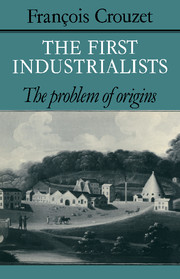7 - The Middle Class in Industry
Published online by Cambridge University Press: 25 October 2011
Summary
As neither the landed class nor the professions nor the lower orders supplied many industrialists, the majority of them came from the business middle class, a view which is neither new nor startling, but which the samples and the tables allow one to elaborate and to endow with some precision.
A glance at the tables will show that the top layers of the business world, which in the eighteenth century belonged, like professional men, to the established elites and had connections with the upper class, were not the nursery of many industrialists. This holds for the merchants engaged in foreign and especially colonial trade, the ‘merchant-princes’ of the main seaports. The sample includes only one well-known overseas merchant, Kirkman Finlay, from Glasgow, and his is not a clear-cut case. His father had been an importer of linen yarn and exporter of linen; he joined him as partner and succeeded him; he greatly developed the business (with ‘colonial’ merchants as partners) and at the same time he went into cotton manufacturing and employed large numbers of handloom weavers. Between 1798 and 1806, he bought, and put back on their feet, three large cotton-spinning mills. During the Napoleonic wars, he exported cotton yarn, cottons and colonial produce, and after 1813 he entered the East India trade on a large scale. So he was both, and pari passu, merchant and industrialist, rather than merchant-turned-industrialist.
- Type
- Chapter
- Information
- The First IndustrialistsThe Problem of Origins, pp. 99 - 115Publisher: Cambridge University PressPrint publication year: 1985



